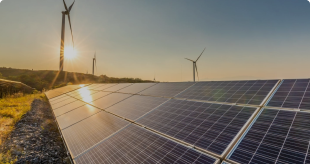In the early 1920s, the GOELRO plan was developed, under which nearly a third of new energy capacities were to be introduced in Ukraine. In April 1928, the First All-Ukrainian Energy Congress was convened, where the electrification plan for Ukraine under the GOELRO project was discussed. This included the approval of the construction of a large hydroelectric power plant on the Dnipro River and industrial power plants in the Donbas region.
Under this plan, several regional and industrial power plants were to be rapidly built in Ukraine, including the Shterivska, Zuyivska, Kryvorizka, Kharkivska, Starobeshevska, and Lysychanska power plants.
By the end of 1940, Ukraine's power plant capacity reached 2,630 MW, while electricity production rose to 12.41 billion kWh. State-owned regional power plants, which produced over 85% of Ukraine’s electricity, formed the backbone of Ukraine’s energy sector. The centralization of electricity and heat production became the most significant and distinctive feature of Ukraine's energy development.
The development of the electricity sector and advances in science created a need to unite the efforts of scientists and practitioners. This led to the establishment of design and scientific institutes, research laboratories, the number of energy specialists in higher educational institutions had increased, and Ukraine's domestic energy machine-building industry had been thriving.
Energy Sector During and After WW II
In the first months of World War II (1941–1945), the operations of energy enterprises were primarily directed toward supporting the needs of the front lines and in the rear. Before the occupation of Ukraine, most of the equipment from power plants was dismantled and evacuated eastward. The equipment that remained was destroyed.
After liberation from the occupiers, the restoration of the energy sector became an essential and intense task.
In the early post-war years, there was a severe shortage of energy capacities, necessitating the use of diesel power plants, energy trains, small hydroelectric power plants, and so on. The reconstruction of power plants was carried out simultaneously with their technical improvement, using the advanced scientific and technical achievements of that time. This included equipment operating at higher steam parameters, automation of production processes, and control over the operational modes of equipment. Some power plants were зфкешфддн equipped with German hardware obtained as war trophies. The dedicated work of energy specialists enabled the rapid reconstruction and further development of Ukraine’s energy sector.
By 1959, the total capacity of Ukraine's power plants exceeded 9 million kW.
Development of Ukraine's Energy System
The next period of Ukraine's economic development was marked by rapid growth in housing and industrial construction, science, and technology. In September 1962, the Ministry of Energy and Electrification of Ukraine was established, consolidating all energy systems and most energy enterprises and organizations within the republic.
The formation of a specialized ministry played a major role in the further development of Ukraine's energy sector, which advanced through the construction of large thermal power plants with supercritical steam parameters and power units of 150-200-300-800 thousand kW capacity, the construction of a cascade of hydroelectric power plants on the Dnipro River, and, in the 1970s, the commissioning of nuclear power units with RBMK and VVER reactors (including Chornobyl, South Ukraine, Zaporizhzhia, Rivne, and Khmelnytskyi NPPs). The ongoing development of power grids across all voltage levels from 0.4 to 750 kV enabled the integration of all energy systems into a single, powerful energy network.
New scientific and design institutes, installation and commissioning energy organizations, energy construction trusts and managing bodies were established in Ukraine, carrying out extensive work volumes.
The Unified Energy System of Ukraine (UES) eventually connected with the energy systems of Hungary, Czechoslovakia, Poland, Romania, and Bulgaria through 220-400 kV transmission lines, becoming a part of the energy association MIR, created by the The Council of Economic Mutual Assistance countries.
A cascade of hydroelectric power stations on the Dnieper was created at an accelerated pace. From 1950 to 1980, Kakhovska, Kremenchutska, Dniprodzerzhinska, Kanivska HPPs and Dniprovsk HPP-2 were built. Near Kyiv, a unique hydropower complex was constructed as part of a hydropower plant with the first horizontal capsule hydroelectric units in the USSR with a total capacity of 352 MW. As well as the country's first Hydro-storage power plant (HSPP) with a capacity of 225 MW. Hydroelectric plants took on a key role in covering peak loads and regulating frequency within the UES.
In 1963, 300 MW power units were put into operation at the Prydniprovska, and over time - at the Kryvorizka, Zaporizka, Zmiivska, Vuglegirska, and Zuivska Condensation Power Plants.
The further development of electrical networks led to the joining of new regions of Ukraine to the general network. And the commissioning of the 330 kV Ivano-Frankivsk - Ternopil transmission line in 1967 made it possible to combine the western power system "Lvivenergo", which worked in parallel with the MIR UES, with the combined power system of the South and form the UES of Ukraine. The construction of a 750 kV transmission line was the final stage of the formation of the UES and the provision of Ukraine's export opportunities.
Zahidnoukrainskaya 750 kV substation – Albertirshe (Hungary) became a continuation of the 750 kV Donbas-Dnipro-Vinnytsia-Zakhidnoukrainskaya latitudinal transmission with a length of 1,120 km.
During the 1970s and 1980s, the construction of a cascade of Dnieper hydroelectric power plants was completed, power units of 800 MW were put into operation at Slovyanska, Vuglegirska and Zaporizhzhya TPPs, power units at nuclear power plants with a capacity of 1,000 MW, heating power units with a capacity of 100 and 250/300 MW were put into operation at thermal power plants. The largest power plants were Zaporizhzhya and Vugleghirska TPPs with a capacity of 3.6 million kW each, Kryvorizka TPP-2 with a capacity of 3 million kW, Prydniprovska, Burshtynska, Zmiivska - with a capacity of 2.4 million kW each, Starobeshivska and Luhansk with a capacity of 2.3 million kW each, Slov' Janska TPP - 2.1 million kW and others.
At the end of the 80s, the capacity of thermal power plants was 37.7 million kW, or 80% of the capacity of all power plants in Ukraine, and the total production of electricity reached 214.4 billion kWh.
In Kyiv, the largest in Ukraine, CHP-5 with a capacity of 800 MW and the world's first 250-300 MW turbine generators was built, and the largest in Kharkiv, CHP-5, was constructed, among others. In 1976-90s, 590 km of main and distribution heating networks were built (with the total length of 2,148 km in 1980) and put into operation in the country's cities to supply heat to the consumers,
In 1975, after the second stage of the DniproHES was put into operation, the construction of a cascade of eight hydroelectric power plants on the Dnipro River with a total capacity of 3910 MW was completed. The construction of the Dniester HPP - PSPP (Pumped storage power plant) began. The commissioning of Rivne NPP in 1986 (with a capacity of 1880 MW), Khmelnytsky NPP in 1987 (1000 MW), and South Ukrainian NPP in 1989 (3000 MW) with VVER power units significantly increased the capacity of Ukraine's energy system. With the commissioning of the last, 6th 1000 MW unit in 1995, the construction of Europe's largest Zaporizhzhya NPP with a capacity of 6000 MW was completed.
The United Power System (UPS) of Ukraine has become one of the most powerful power systems in Europe. The installed capacity of power plants exceeded 50 million kW. The total length of power transmission lines of all voltage classes exceeded 1 million kilometers, and the number of transformer substations of all voltage classes totaled 202 thousand units.
On April 6, 1986, Ukraine suffered a catastrophe - a powerful explosion occurred at the RBMK reactor of Chornobyl NPP Unit 4 during a production experiment, releasing large amounts of radioactive substances into the environment. It was one of the largest man-made disasters in the world. Chornobyl demonstrated to the whole world how important it is to ensure the reliable operation and development of Ukraine's nuclear energy complex.
The political decision to shut down the Chornobyl NPP caused a huge global outcry. On December 15, 2000, in accordance with the decision of the Verkhovna Rada of Ukraine, the operation of ChNPP Unit 3 was suspended and the power plant was finally shut down.
The Ukrainian Nuclear Society was established in 1993 with the participation of the professional community.
Reforming the energy sector and market transformation
At the beginning of the 90s of the 20th century, the energy system of Ukraine was a vertically integrated energy complex, and the issue of energy reform and its transition to market relations was widely discussed among specialists of the Ministry of Energy, the Ministry of Economy, the Antimonopoly Committee, and in scientific and public organizations. In the mid-1990s, the World Bank was appointed as the coordinator for the development of the wholesale electricity market model, and it engaged foreign consultants to develop the model. The principles of preserving the United Energy System of the country and its centralized management, demonopolization of regional energy associations, and creation of conditions for competition among energy producers and suppliers of electric energy were laid as a basis for the reform of the industry and the creation of the electricity market.
According to this program, the State Power Company of Main Power Grids (220-750 kV) was established, while operational dispatch services of regional energy associations were subordinated to The National Dispatch Center (NDC). On April 15, 1998, these two state structures were merged into the National Energy Company "Ukrenergo", which is not subject to privatization.
In order to create market prerequisites for the functioning of the energy industry, monopolistic, vertically integrated energy associations were liquidated. On their basis, seven energy-generating companies (thermal power plants, nuclear power plants, hydroelectric power plants) were created.
All these companies created the Wholesale Electricity Market (WER) by signing the WER Participant Agreement in 1996. Later, the contract was also signed by independent energy suppliers, which received the right to buy energy on the wholesale electricity market.
During the transition period, the centralized management of the energy sector by the Ministry of Energy significantly decreased. As early as 1995, the President of Ukraine established the National Electricity Regulatory Commission (NERC) by a decree, which was tasked with regulating the wholesale market, licensing energy activities, tariff policy, and protecting the rights of electricity consumers.
On October 16, 1997, the Law was adopted by the Verkhovna Rada of Ukraine.
The State Enterprise “Energorynok” was established as part of the NDC to perform the functions of the market operator.
At the end of 1999 by Presidential Decree, the Ministry of Fuel and Energy of Ukraine was established on the basis of the Ministry of Energy, the Ministry of Coal Industry, the State Department for Electricity, the State Department for Oil, Gas and Oil Refining, and the State Department for Nuclear Energy.
The modern energy system of Ukraine
Today, the United Power System of Ukraine is one of the largest power systems in Europe, comprising seven regional power systems (RPS): Dnipro, Western, Crimean, Southern, Southwestern, Northern and Central, which are interconnected by backbone and trunk power lines of 750 kV and 330-500 kV2.
The structure of the national power system includes different types of power plants, trunk and distribution networks located over a large territory and united by a common mode of generation, transmission and distribution of electricity and heat.
The operation mode of the UPS of Ukraine is determined based on the balance of electricity production and consumption, repair of power grids and power generating equipment, as well as the ability to eliminate emergencies in case of power plant shutdowns and damage to trunk power lines. The national power system has 413 electricity producers, of which seven are powerful power generating companies that provide about 90% of total production, 40 electricity transmission companies through local power grids, and 147 electricity supply companies.
On March 16, 2022, a historic event took place: the Ukrainian power system was finally disconnected from its Soviet past - the power grids of russia and Belarus. Against the backdrop of the russian military invasion, more than a year ahead of schedule, Ukraine's power system was fully synchronized with the ENTSO-E power grid of continental Europe. The relevant decision was made by the ENTSO-E association of system operators on March 11, 2022. After the synchronization, the UPS of Ukraine operates stably, with the frequency maintained at 50 Hz.








